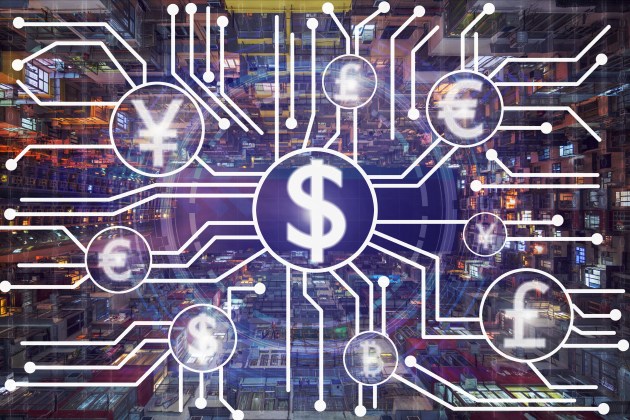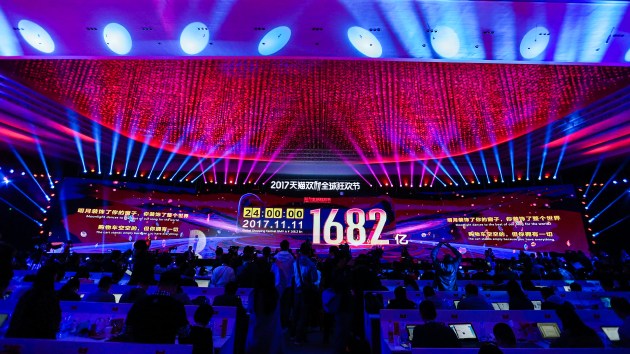Mining Gold in Cyberspace
The Explosion of the Data Economy

Source:Getty Images
In the 20th century, having oil meant having power and influence. In the 21st century, data has supplanted oil as the resource of choice. But having it isn’t enough. What is it that is separating the winners from the also-rans in this data-driven age?
Views
The Explosion of the Data Economy
By Shu-ren Koo, Fuyuan HsiaoFrom CommonWealth Magazine (vol. 637 )
We are living in an age where “data” is everywhere. From the time you wake up, your smartphone records your every movement – where you’ve been, who you’ve called or texted, and what apps you’ve used.
After you get to work and turn on your computer, Google uses its browser to collect complete data on the websites you visit and the links you click on, only to turn around and bombard you with personalized advertisements.
When you go out for lunch and pay the bill, what you ate, the cost of each item and the hour of the day are stored in the restaurant’s computer, enabling the business to better understand your consumption habits and preferences.
Go for a drive and the smartphone in the car quietly transmits information on your location to your internet provider, which then compares the concentration of phone messages along that particular stretch of road with other data to provide drivers accurate, up-to-the-minute traffic conditions on their mobile phone map.
Welcome to the Data Economy!
Society today can no longer function without data. Its importance as an indispensable part of our daily lives has turned data into the oil of this new age – its most important resource and asset.
In the 20th century, oil was an essential part of life, without which modern societies could not function. But in the 21st century, “the world’s most valuable resource is no longer oil, but data,” an Economist headline blared in May 2017. “Data are to this century what oil was to the last one: a driver of growth and change.
Whoever can apply data the best will emerge the winner. “A country’s ability to exploit data in safe and creative ways will increasingly determine its success,” wrote Financial Times Innovation Editor John Thornhill in a column in late October.
Why are prominent media making these claims? Just look at the companies that are sweeping across global markets and upending the traditional rules of the game.
Apple, Google, Microsoft, Amazon and Facebook have become the world’s five most valuable companies and seen their share prices rise much faster over the past five years than the S&P 500 index precisely because they have monetized data more effectively than any other company.
“Google was the first company in the world to treat data as a production resource,” said Wang Jian, a key player in the development of Alibaba Cloud and the chairman of technology on Alibaba Group Holding’s Steering Committee, during a recent speech in Taipei.
China’s Alibaba, Tencent and Baidu, along with TSMC in Taiwan, have also emerged as leaders in their fields because of their adept use of data analytics.
Many of today’s hottest tech innovations, from artificial intelligence, autonomous vehicles and robots to augmented reality, virtual reality and Industry 4.0, are also being driven by big data, which has enabled the emergence of new technologies, new services and new business models.
“You can’t have artificial intelligence without data,” Wang said. “Amazon and Microsoft’s lead in the development of artificial intelligence is because of their extensive experience in analyzing large amounts of data.”
Data has been collected and analyzed since computers first appeared on the market. But the growing sophistication of data collection, transmission, storage and analysis technologies in recent years, the declining costs of those technologies, and the gradual strides being made by AI have resulted in the widespread adoption of analytics in every sector.
“If data is oil, then artificial intelligence is the refinery making it possible for big data analysis to enter a new era,” says Wang Yun, the technology director of the Industrial Technology Research Institute’s Computational Intelligence Technology Center.
According to a BSA/The Software Alliance estimate, 98 percent of all global data has been generated in the past two years, and the sheer volume of data is expected to grow exponentially in the future as more devices are used to browse the internet.
In the “data economy” era, the key to victory is the ability to generate nuggets of gold from the massive amount of data available that deliver value to people’s lives, company operations, and public governance, much like oil is refined at various levels of the petrochemical value chain to create products useful for daily living.
“I would argue that Google really does have a better product than the competition – not because we have more or better ingredients [data], but because we have better recipes [analysis capabilities],” Google chief economist Hal Varian wrote in a widely quoted blog post back in 2008.
As a result, data resources seem to be monopolized by massive internet companies like Google, Facebook, Amazon, Alibaba and Tencent. In fact, however, anybody who understands how to apply data can become a data economy “refinery,” helping themselves do things they couldn’t do before and create new value.
“Just like the invention of the light bulb led to people having more time in which they could be active, data and stronger computing capabilities will create another world for us,” Alibaba’s Wang said.
 O-Bank does not have any physical branches and relies entirely on big data to understand customers and generate competitive advantages. (Image: Ming Yang)
O-Bank does not have any physical branches and relies entirely on big data to understand customers and generate competitive advantages. (Image: Ming Yang)
Using Data to Identify VIPs
Compared with the service and manufacturing sectors, Taiwan’s financial services sector was the earliest to enter the data economy and the first to be shaken up by technological change.
In CommonWealth Magazine’s latest Top 2000 CEO Survey of Taiwanese business leaders, 80 percent of respondents believed that big data analysis was “important” (Table 1). Of that group, nearly 90 percent of respondents from the financial sector said their companies were involved in big data analysis (Table 2), a far higher percentage than for respondents from the manufacturing and service sectors.


The main goal of big data analysis was to gain insight into the different needs of different customers and engage in precision marketing, the survey found. (Table 3)

In 2017, O-Bank Co. became Taiwan’s first domestic online bank. When top executives arrive at the office, they immediately head to their management war room to check on the latest operations data and charts.
Their “data dashboard,” which helps a company visualize its many metrics, provides real-time information on customer numbers and the channels they used to access the bank’s services.
“Who is he? How did he get here? What is the most effective channel? Decisions can be made immediately to adjust marketing promotions,” says O-Bank Senior Vice President Michelle Liu who heads the bank’s Data Intelligence Department.
It takes 11 steps to open an account with the bank, and when customers start but do not complete the process, the digital platform can detect at which point they dropped out and make improvements as necessary.
O-Bank was also Taiwan’s first financial institution to use robot advisors, relying on analytics to engage in precision marketing, identify potential loan customers and control investor risk. These robot consultants also compile data from global investment markets to help customers choose the most suitable investment targets and monitor their portfolios.
Liu openly acknowledges the challenge posed by not having physical branches and the bank’s lack of real contact with its customers.
“We use big data to understand customers; that’s a major reversal from the past,” she says, explaining that in the data economy era, “banks must rely on the power and speed of data to forge competitive advantages.”
In one of the linchpins of the service sector, the food and beverage industry, the biggest management challenge is finding target customers and increasing their “stickiness,” their willingness to stick with a brand or service.
At the beginning of 2016, President Starbucks Coffee Corp. launched a “My Starbucks Rewards” loyalty program in Taiwan that goes beyond allowing customers to earn points and trade them in for rewards. Just as important to the company is the mobile phone app used by customers to pay for their orders because it records what each person purchased, the amount spent, and when the transaction was made.
Once this data is compiled and analyzed, President Starbucks has a clear picture of each member’s habits and preferences, and it capitalizes on that knowledge to send them personalized information on special offers or special products. The strategy has the dual advantage of making members feel like VIPs, increasing their “stickiness,” and creating a new revenue stream.
 President Starbucks uses its rewards program to analyze consumer behavior and identify and nurture VIP customers. (Image: Chien-ying Chiu)
President Starbucks uses its rewards program to analyze consumer behavior and identify and nurture VIP customers. (Image: Chien-ying Chiu)
“For people who come often to buy breakfast, for example, we target those customers with notifications on special breakfast offers, getting them to come back,” says Charles Ho, marketing director of President Starbucks and the person responsible for the “My Starbucks Rewards” program.
At the same time, the technology offers insight into which members have not spent anything or spent very little for an extended period of time, or which of them have never purchased anything but a beverage, enabling the company to target them with specially devised incentives to get them to spend more.
“In the past, we had no idea with whom we should communicate. Now we know, and we have a clear picture of their habits and preferences,” Ho says. “So we then take that information and discuss among ourselves what Starbucks can offer them.”
The rewards program may have been in place for fewer than two years, but it has already attracted nearly 1.4 million members, who contribute half of the coffee chain’s annual revenues in Taiwan.
Mining the Unspoken Feelings of Consumers
The manufacturing sector has also started to embrace the use of data to better understand customers and design products more closely aligned with consumer needs.
South Korean consumer product giants Samsung and LG take the pulse of social media opinions and feelings before developing a new product and use their findings, for example, in deciding on the colors and functions in their new smartphones.
Similarly, before finalizing a redesign of its popular keyboard models, Chinese computer vendor Lenovo Group once gathered posts and articles from social network web pages to see what consumers were thinking. The company came across a commentary on Lenovo keyboards in a small online gaming community that had more than 2,000 comments attached.
After analyzing the posts, Lenovo found that consumers liked the keyboards just the way they were and decided to cancel the redesign that was ready to go.
“You can also analyze unstructured text and voices to gauge consumer sentiment and detect warning signals that companies can handle in real time. They don’t have to wait for consumers to protest and then be forced to engage in damage control,” explains Alen Chen, director of the Pre-Sales Support Department of SAS Institute, the global leader in the advanced analytics market.
Before the data economy era, companies preparing to launch a new product or service relied primarily on market research and focus groups, but those techniques were not able to precisely reflect how consumers truly felt in real time.
Today, however, analytics are used to automatically scan or “crawl” social media sites, deconstruct text, analyze vocabulary and judge whether sentiment is positive or negative, and ultimately serve as a data dashboard. The process lets companies hear the opinions that consumers are not willing to reveal in market research interviews.
“In an age when the volume of information is exploding, you can’t rely on your feelings or instincts to make decisions. Only analytics can tell you the truth,” says Simon Koh, the chief brand officer of the Brand Accelerator Center under Taiwan’s General Chamber of Commerce.
 Alibaba technology leader Wang Jian says Alibaba’s success is because it has used data more effectively in the internet age than any other company. (Image: Alibaba News)
Alibaba technology leader Wang Jian says Alibaba’s success is because it has used data more effectively in the internet age than any other company. (Image: Alibaba News)
Technology not the Most Important Factor
When applied to manufacturing, this type of early warning system and dealing with problems in real time means detecting when a machine or production line has even a slight abnormality and doing the proper maintenance ahead of time to prevent breakdowns or stoppages. This is one of Industry 4.0’s most important applications – preventive maintenance.
GE is a huge advocate of the concept. It has installed sensors in the 26,000 locomotives it has made that transmit data every five seconds on locomotive and wheel wear and rail abrasion and help predict when parts will fail. Armed with that information, railways can replace parts before something goes wrong, making rail travel safer and more efficient.
The technology means that you don’t have to wait for equipment to break down before replacing it and also results in fewer accidents and less time and expense devoted to maintenance, Garret Fitzgerald, general manager of Transport Intelligence at GE Transportation Digital Solutions, told a CommonWealth reporter at SAS’s 2017 Analytics Experience in Amsterdam.
In Taiwan, band saw manufacturer Cosen also installs sensors in its machines to collect blade and machine performance data that is then analyzed to monitor blade life and predict blade failure. The technology addresses customers’ “pain points” by advising them when to change blades and allowing the machines to function without the need for an engineer to watch over them.
Babson College professor and analytics expert Thomas Davenport told CommonWealth in an interview that in the data economy age how much data companies have or the technologies they use are not the keys to success.
"Extracting value from information is not primarily a matter of how much data you have or what technologies you use to analyze it,” he says. “It’s how aggressively you exploit these resources and how much you use them to create new or better approaches to doing business."
Translated from the Chinese article by Luke Sabatier
Additional Reading
♦ Chronicling a 20-Year Decline
♦ Can Xi’s ‘National Treatment’ Strategy Work?
♦ The Future of Manufacturing: Germany's Industry 4.0 Strategy
♦ Startling Statistics from Singles' Day







